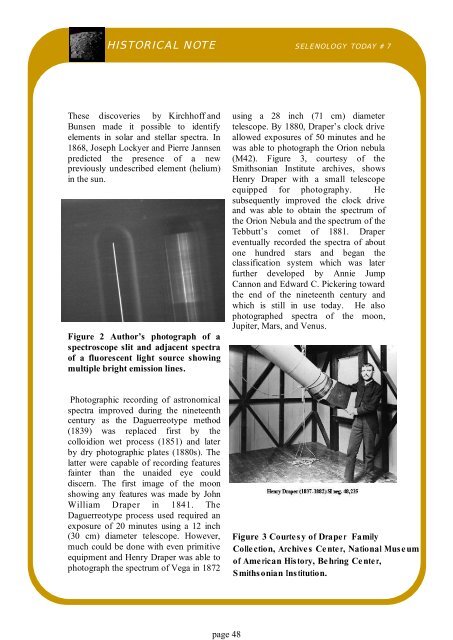Selenology Today # 7 July 2007 - Home
Selenology Today # 7 July 2007 - Home
Selenology Today # 7 July 2007 - Home
Create successful ePaper yourself
Turn your PDF publications into a flip-book with our unique Google optimized e-Paper software.
HISTORICAL NOTE SELENOLOGY TODAY # 7<br />
These discoveries by Kirchhoff and<br />
Bunsen made it possible to identify<br />
elements in solar and stellar spectra. In<br />
1868, Joseph Lockyer and Pierre Jannsen<br />
predicted the presence of a new<br />
previously undescribed element (helium)<br />
in the sun.<br />
Figure 2 Author’s photograph of a<br />
spectroscope slit and adjacent spectra<br />
of a fluorescent light source showing<br />
multiple bright emission lines.<br />
Photographic recording of astronomical<br />
spectra improved during the nineteenth<br />
century as the Daguerreotype method<br />
(1839) was replaced first by the<br />
colloidion wet process (1851) and later<br />
by dry photographic plates (1880s). The<br />
latter were capable of recording features<br />
fainter than the unaided eye could<br />
discern. The first image of the moon<br />
showing any features was made by John<br />
William Draper in 1841. The<br />
Daguerreotype process used required an<br />
exposure of 20 minutes using a 12 inch<br />
(30 cm) diameter telescope. However,<br />
much could be done with even primitive<br />
equipment and Henry Draper was able to<br />
photograph the spectrum of Vega in 1872<br />
page 48<br />
using a 28 inch (71 cm) diameter<br />
telescope. By 1880, Draper’s clock drive<br />
allowed exposures of 50 minutes and he<br />
was able to photograph the Orion nebula<br />
(M42). Figure 3, courtesy of the<br />
Smithsonian Institute archives, shows<br />
Henry Draper with a small telescope<br />
equipped for photography. He<br />
subsequently improved the clock drive<br />
and was able to obtain the spectrum of<br />
the Orion Nebula and the spectrum of the<br />
Tebbutt’s comet of 1881. Draper<br />
eventually recorded the spectra of about<br />
one hundred stars and began the<br />
classification system which was later<br />
further developed by Annie Jump<br />
Cannon and Edward C. Pickering toward<br />
the end of the nineteenth century and<br />
which is still in use today. He also<br />
photographed spectra of the moon,<br />
Jupiter, Mars, and Venus.<br />
Figure 3 Courtesy of Draper Family<br />
Collection, Archives Center, National Museum<br />
of American History, Behring Center,<br />
Smithsonian Institution.


